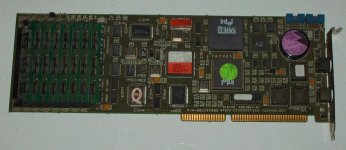kishy
Veteran Member
Posting this as I head off to bed with hopes there will be fun, juicy info when I awaken:
Yesterday I went to a garage sale at a local charity that refurbs computers for children, schools, etc. They take donations so naturally they've accumulated a significant amount of vintage stuff over the years (ex: there's a box of 10+ C64s of the varying generations).
I think I lucked out. For $20:
The SBC is in the attached photo.
It has two mini-DIN jacks (PS/2 type but I can't be sure that's what they actually carry), a big fat CMOS battery, loaded with RAM, has a 386 w/387, what appear to be two COM port headers...you get the idea. Diversified seems to have been involved with slot machines and arcade stuff and my understanding is local arcades were big donors (and buyers and traders) with the charity in question, so that fits. It's a 16-bit ISA card, or at least interfaces via a physically equivalent connector. Popped it in my P1 test rig just to see if anything started arcing and the system didn't POST, but seemingly no harm done (removed it and system works again). Any info? I'm not 100% sure what/where the model number is on this but the p/n is visible in the photo (CAT985 is another possibly significant figure).
Yesterday I went to a garage sale at a local charity that refurbs computers for children, schools, etc. They take donations so naturally they've accumulated a significant amount of vintage stuff over the years (ex: there's a box of 10+ C64s of the varying generations).
I think I lucked out. For $20:
- IBM 1386887 3179 terminal keyboard, for conversion project at geekhack.org
- NIB PS/2 RF wireless mouse
- Kensington Expert Mouse serial trackball w/cable and PS/2 adapter
- AT/XT keyboard extension cable, 6ft
- PS/2 extension cable, 6ft
- Diversified Technology Single Board Computer
The SBC is in the attached photo.
It has two mini-DIN jacks (PS/2 type but I can't be sure that's what they actually carry), a big fat CMOS battery, loaded with RAM, has a 386 w/387, what appear to be two COM port headers...you get the idea. Diversified seems to have been involved with slot machines and arcade stuff and my understanding is local arcades were big donors (and buyers and traders) with the charity in question, so that fits. It's a 16-bit ISA card, or at least interfaces via a physically equivalent connector. Popped it in my P1 test rig just to see if anything started arcing and the system didn't POST, but seemingly no harm done (removed it and system works again). Any info? I'm not 100% sure what/where the model number is on this but the p/n is visible in the photo (CAT985 is another possibly significant figure).

